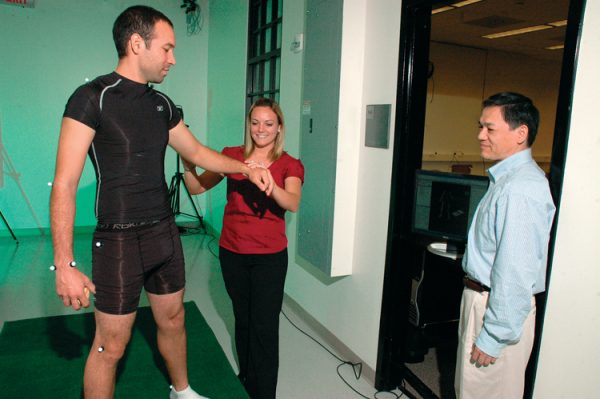Motion Study Research Helps Athletes Prevent Injuries

In his motion study research, Dr. Nigel Zheng has worked with subjects ranging from University of Florida quarterback Tim Tebow to the entire New York Mets pitching staff.
An assistant professor of Mechanical Engineering and Engineering Science, Dr. Zheng, along with his lab, are experts in biomechanics as related to the motion of the human body. Through their motion analysis research, they are working with professional and amateur athletes to understand and prevent sports injuries.
As part of a three-year contract with Major League Baseball, Dr. Zheng is now working on the elbow and shoulder problems of pitchers.
“Baseball pitchers are very interesting, because their arms have been trained from a very young age,” Dr. Zheng said. “Their muscles, tendons and joints have adapted to meet the demands of the throwing motion, and are actually different than other people’s. So, our studies have to be very specific to just pitchers.”
In their analysis of pitchers, the researchers use high-speed cameras that shoot 240 frames a second, and wireless devices that record loads on the elbow and shoulder. From this quantitative physical exam, the individual’s pitching mechanics are compared with norms and throwing-arm-injury data collected from 60 major league pitchers.
“The ultimate goal of the research is early prediction of possible injuries,” Dr. Zheng said. “By doing these exams and then tracking the players, we can quantify the stresses on the body. We can then work with doctors and trainers to say, ‘based on this type of body condition and pitching motion, this person is susceptible to these types of injuries.’ They can then work to develop training programs to help prevent the injuries.”
Another area of Dr. Zheng’s research is from the surgical point of view, once an injury does occur. His lab is specifically focusing on ACL knee reconstructions.
“Doctors are finding that in 40 to 50 percent of ACL cases, patients develop osteoarthritis in about 15 years,” Dr. Zheng said. “This then leads to total knee replacement surgery, which also only lasts about 15 years.”
To see why some ACL surgeries fail and some succeed, Dr. Zheng and his lab are building a database of patients and the different surgical procedures and techniques used in their ACL reconstruction. They are then doing imaging, stress and impact tests to calculate bone motion and determine bone shift during daily activities.
“We are looking at what happens after ACL surgery when a person returns to their regular routine,” Dr. Zheng said. “We want to be able to determine early on what is happening, and when we see problems find ways to prevent them from worsening.”
An important area for all of Dr. Zheng’s research is computer simulation and monitoring. The lab is developing computer models to mimic body movement that are based on all of their motion studies. With this computer information, it will be possible to determine internal joint forces without having to do expensive patient studies. His research has guided physical therapists to develop rehabilitation protocol after ACL reconstruction.
For more information contact Dr. Zheng at nzheng@charlotte.edu.